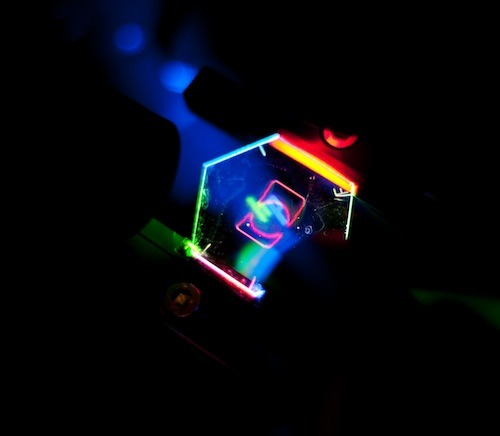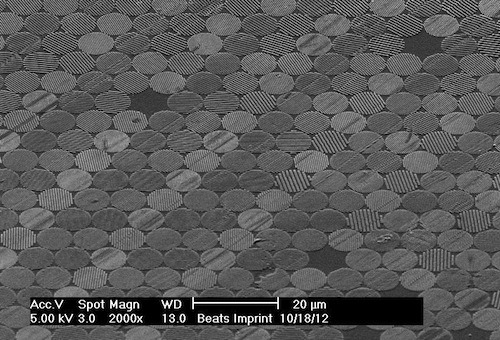
Researchers Create New Generation of 3-D Video, No Glasses Needed
New glasses-free, 3-D video displays for mobile devices from
Hewlett-Packard Labs could soon make mobile phones, tablet computers,
watches and laptops look like windows into other worlds.
HP physicist David Fattal and his colleagues have designed the novel technology that they say is compact, low-cost and especially well suited for mobile display applications.
“We can achieve so-called ‘holovideo’ at a frame rate of 30 frames per second,” Fattal says.
A brief history of illusion
The illusion of 3-D comes from how we see stereoscopically —our two eyes see two slightly different views of the world because they are separated by about 2.5 inches, which the brain fuses into a 3-D model of the world. Conventional 2-D displays show only a single flat image, so both eyes view the same picture on the screen. Three-dimensional displays instead present a different image to each eye.
In the early days of the technology, 3-D movies required viewers to use glasses with a red filter in front of one eye and a green one in front of the other, creating what is called an anaglyph system. These filters presented each eye with a different image. But they also caused headaches.
Nowadays, 3-D movies usually rely on passive polarization, a system in which the two lenses in the viewer’s glasses are polarized in different directions. Each lens lets light waves that ripple only in one direction and not others through. Movies using this technology show two images at the same time, each with a different polarization.
In contrast, most home 3-D televisions employ a different strategy. Known as active shuttering, this technique uses rapidly flickering shutters in the glasses that are synchronized with rapid alternation of left and right images on the screen to present a different image to each eye.
Another theoretical technology for 3-D display that would not require special glasses would use holograms. But as effective as holographic techniques are at generating 3-D effects, they are expensive and too slow for real-time operation.
Still another technique that does not use either special glasses or holograms is called autostereoscopic displays. It uses screens whose pixels each send light in specific directions, as opposed to conventional 2-D displays that send light in all directions. Such glasses-free 3-D displays can project a different image into each of the viewer’s eyes. The more the light can be sent in tuned, specific directions, the further away a viewer can stand in relation to the screen and still perceive a 3-D effect.
A number of autostereoscopic displays have already made their way to market — for instance, the Nintendo 3DS game console offers 3-D images to a single vantage point. In general, though, these multiview 3-D technologies are designed for TV applications. They are not especially suited to mobile devices, which ideally would have thin, high-resolution displays offering wide zones of view.
HP’s innovation
The secret behind the HP’s new glasses-free 3-D display is its backlight. To understand how it works, imagine the backlight is a thin hollow slab whose edges are lined with LEDs that point inward, a bit like how a stadium’s lights shine on its center. The LEDs come in three colors — red, green and blue — that can be used to recreate the full range of colors of light.
One side of this backlight is covered with tiny round grates that serve as the display’s pixels. These gratings are roughly 10 microns wide, or a tenth the average width of a human hair, and separated by about 35 microns. The way the LEDs are angled leads the rays of light from them to reflect off the inner walls of the backlight in a zigzag manner, and a little bit of light emerges from each grate during each bounce.
The grooves of each grating are between 120 and 500 nanometers or billionths of a meter wide. Light waves hitting the grates scatter, resulting in multiple rays that each travel from a pixel in a specific direction.

(A scanning electron microscope picture of the backlight surface for the HP logo shown in the picture at top. It shows a close packed array of grating pixels. Courtesy Albert Jeans.)
The light from this backlight is then shone through a translucent frontplane, much as the light from a movie projector is shone through reels of movie film. When the backlight is applied, the image each eye sees is different, generating the 3-D illusion. Other observers in different locations relative to the display can also see it. Without the backlight, the frontplane would just look like an incoherent jumble, comprised of images visible from multiple points of view all fused together.
The research team’s first prototype, developed in the summer of 2011, had a 4-millimeter-wide letter “X” floating 4 millimeters above a letter “O.”
“The morning we saw the 3-D effect for the first time, we knew we were onto something,” Fattal recalls. “I would be embarrassed to tell you how many hours we spent staring at the ‘XO’ image that day.”
New 3-D tech advancing quickly
In less than two years, Fattal and his team have developed a series of more advanced prototypes. Using a high-resolution commercial liquid-crystal display (LCD) as the frontplane, the researchers could generate 3-D video at 30 frames per second with a resolution of 88 pixels per inch visible from 64 different viewpoints. They also developed several transparent handheld prototypes that could each show up to six different 3-D images visible from 200 different viewpoints at a resolution of 127 pixels per inch, comparable to a conventional laptop screen.
“With the transparent displays, you can see your hand underneath them,” Fattal says.
The scientists found they could manufacture the backlight using a continuous roll-to-roll process, producing them at very low cost. Thin sheets containing the gratings could get cut and glued onto cheap plastic backings lined with commercially available LEDs, and each backlight might cost about a dollar or less to make, Fattal says.
The researchers warn that these displays do not generate 3-D images floating above them. “People keep asking us if we will be able to project Princess Leia from a cell phone,” Fattal says. “Even though the Star Wars movie was helpful in popularizing the concept of holovideos, it gave the impression that holograms could be projected in the middle of a room from a small projector device.”
Rather, these displays appear like windows looking onto 3-D scenes. “We can display a 3-D version of Princess Leia, but she must fit within the boundaries defined by the viewer’s eye and the edges of the display,” Fattal says.
Top Image: A 3-D image of an HP logo in RGB, from a completely transparent substrate. Courtesy Kar Han Ta.
HP physicist David Fattal and his colleagues have designed the novel technology that they say is compact, low-cost and especially well suited for mobile display applications.
“We can achieve so-called ‘holovideo’ at a frame rate of 30 frames per second,” Fattal says.
A brief history of illusion
The illusion of 3-D comes from how we see stereoscopically —our two eyes see two slightly different views of the world because they are separated by about 2.5 inches, which the brain fuses into a 3-D model of the world. Conventional 2-D displays show only a single flat image, so both eyes view the same picture on the screen. Three-dimensional displays instead present a different image to each eye.
In the early days of the technology, 3-D movies required viewers to use glasses with a red filter in front of one eye and a green one in front of the other, creating what is called an anaglyph system. These filters presented each eye with a different image. But they also caused headaches.
Nowadays, 3-D movies usually rely on passive polarization, a system in which the two lenses in the viewer’s glasses are polarized in different directions. Each lens lets light waves that ripple only in one direction and not others through. Movies using this technology show two images at the same time, each with a different polarization.
In contrast, most home 3-D televisions employ a different strategy. Known as active shuttering, this technique uses rapidly flickering shutters in the glasses that are synchronized with rapid alternation of left and right images on the screen to present a different image to each eye.
Another theoretical technology for 3-D display that would not require special glasses would use holograms. But as effective as holographic techniques are at generating 3-D effects, they are expensive and too slow for real-time operation.
Still another technique that does not use either special glasses or holograms is called autostereoscopic displays. It uses screens whose pixels each send light in specific directions, as opposed to conventional 2-D displays that send light in all directions. Such glasses-free 3-D displays can project a different image into each of the viewer’s eyes. The more the light can be sent in tuned, specific directions, the further away a viewer can stand in relation to the screen and still perceive a 3-D effect.
A number of autostereoscopic displays have already made their way to market — for instance, the Nintendo 3DS game console offers 3-D images to a single vantage point. In general, though, these multiview 3-D technologies are designed for TV applications. They are not especially suited to mobile devices, which ideally would have thin, high-resolution displays offering wide zones of view.
HP’s innovation
The secret behind the HP’s new glasses-free 3-D display is its backlight. To understand how it works, imagine the backlight is a thin hollow slab whose edges are lined with LEDs that point inward, a bit like how a stadium’s lights shine on its center. The LEDs come in three colors — red, green and blue — that can be used to recreate the full range of colors of light.
One side of this backlight is covered with tiny round grates that serve as the display’s pixels. These gratings are roughly 10 microns wide, or a tenth the average width of a human hair, and separated by about 35 microns. The way the LEDs are angled leads the rays of light from them to reflect off the inner walls of the backlight in a zigzag manner, and a little bit of light emerges from each grate during each bounce.
The grooves of each grating are between 120 and 500 nanometers or billionths of a meter wide. Light waves hitting the grates scatter, resulting in multiple rays that each travel from a pixel in a specific direction.

(A scanning electron microscope picture of the backlight surface for the HP logo shown in the picture at top. It shows a close packed array of grating pixels. Courtesy Albert Jeans.)
The light from this backlight is then shone through a translucent frontplane, much as the light from a movie projector is shone through reels of movie film. When the backlight is applied, the image each eye sees is different, generating the 3-D illusion. Other observers in different locations relative to the display can also see it. Without the backlight, the frontplane would just look like an incoherent jumble, comprised of images visible from multiple points of view all fused together.
The research team’s first prototype, developed in the summer of 2011, had a 4-millimeter-wide letter “X” floating 4 millimeters above a letter “O.”
“The morning we saw the 3-D effect for the first time, we knew we were onto something,” Fattal recalls. “I would be embarrassed to tell you how many hours we spent staring at the ‘XO’ image that day.”
New 3-D tech advancing quickly
In less than two years, Fattal and his team have developed a series of more advanced prototypes. Using a high-resolution commercial liquid-crystal display (LCD) as the frontplane, the researchers could generate 3-D video at 30 frames per second with a resolution of 88 pixels per inch visible from 64 different viewpoints. They also developed several transparent handheld prototypes that could each show up to six different 3-D images visible from 200 different viewpoints at a resolution of 127 pixels per inch, comparable to a conventional laptop screen.
“With the transparent displays, you can see your hand underneath them,” Fattal says.
The scientists found they could manufacture the backlight using a continuous roll-to-roll process, producing them at very low cost. Thin sheets containing the gratings could get cut and glued onto cheap plastic backings lined with commercially available LEDs, and each backlight might cost about a dollar or less to make, Fattal says.
The researchers warn that these displays do not generate 3-D images floating above them. “People keep asking us if we will be able to project Princess Leia from a cell phone,” Fattal says. “Even though the Star Wars movie was helpful in popularizing the concept of holovideos, it gave the impression that holograms could be projected in the middle of a room from a small projector device.”
Rather, these displays appear like windows looking onto 3-D scenes. “We can display a 3-D version of Princess Leia, but she must fit within the boundaries defined by the viewer’s eye and the edges of the display,” Fattal says.
The screens could find use not just in mobile
devices, but larger displays as well. “However, the 3-D image quality
might not be as good as with other approaches out there,” Fattal says.
“Still, a large display could benefit from the transparency and
compactness of our technology.”
The scientists detailed their findings in the March 21 issue of the journal Nature.Top Image: A 3-D image of an HP logo in RGB, from a completely transparent substrate. Courtesy Kar Han Ta.



 Charles Q. Choi
Charles Q. Choi
No comments:
Post a Comment